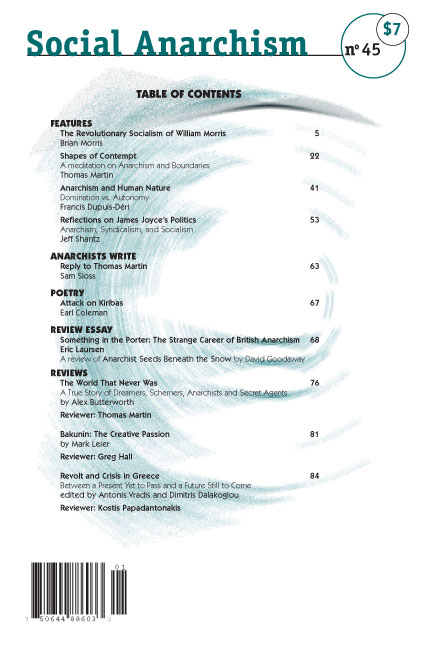Shapes of Contempt
a meditation on anarchism and boundaries
Page: 5
How then should anarchists respond to boundaries and territories, in practice and in theory? Anarchism hopes for a world in which neither exists, at least in their political form. But the boundary of the individual is prior and more fundamental, and that is where we have to start. Radical philosophies have long been interested describing what it means to be an individual. As John Clark has written, ". . . there has been a tendency in recent holistic anarchist thought to explicitly use the term 'individual' to refer to that degraded self fabricated over the long history of social domination, and finally perfected in modern capitalist, statist, technobureaucratic society."[i] Various alternatives have been offered, notably Arne Næss’ “Self-realization,” with a capital S. Drawing on sources as varied as Spinoza, William James, Gandhi and Erich Fromm – and at the same time noting that western philosophy has never been able to come up with a universally acceptable definition of the ‘self’ – Næss suggests that “the ‘everything hangs together' maxim of ecology applies to the self and its relation to other living beings, ecosystems, the ecosphere, and the Earth with its long history.” He adds, “Human nature is such that with sufficient allsided maturity we cannot avoid ‘identifying' ourself with all living beings, beautiful or ugly, big or small, sentient or not.” By “allsided” he means ‘in all major relations,’ that is, when taking our place in the global ecosphere into account.[ii] General systems theory helps to clarify this approach with its description of ‘life’ as a complex of autopoietic systems constantly interchanging matter and energy with each other. Moreover, science has now demonstrated that even such a broad definition does not suffice for ‘life’: "Nature lays down no boundaries between life and nonlife. What we choose to call living is our own affair."[iii]
As is well known, the philosophies of Næss and the deep ecologists overlap considerably with Eastern religions, in particular Zen Buddhism and Taoism (which indeed overlap with each other). Do non-Western peoples perceive a seamless universe without energy or matter, change or permanence, indeed without any notion of or at all? Our first reaction is to say, no, of course not: in spite of their nondualistic philosophies the Zen Buddhists and the Amerind shamans know the difference between thoughts and things. But do they really? We can ask them, of course; but this act of observation changes the results of the experiment. And in any case the modern world is so thoroughly saturated with Western civilization that no one on the planet can be entirely free of its dualistic influence. How would the Caribs have explained the mind/body problem before Columbus 'discovered' them? We have no way of knowing, even in theory.
Most cultures through most of history have used some sort of geomancy to determine the placement of human-made structures. Usually, if not always, the goal is to take advantage of naturally-occurring boundaries or imperceptible forces in order to protect or maximize the efficiency of those forces, and/or not to cross boundaries that ought not to be crossed. The evidence can be found all over the world: the Nazca lines, the careful alignment of the Pyramids, the ley lines (if they exist) of Britain, the astronomical configurations of Ohio’s Moundbuilder structures, Australian songlines, and so on. In most cases we do not understand the philosophy behind these patterns, though intelligent guesses can be made (as well as many unintelligent and downright crackpot guesses). Whether they have any connection with scientifically attested phenomena like telluric currents or the Earth’s magnetic field is an open question. On the other hand, we do know a great deal about some of these geomantic systems.
Feng shui (literally, “wind – water”) has been trivialized into a strategy for the arrangement of beds, tables and various consumerist clutter into patterns that can supposedly improve mental and physical health for the owners of said impedimenta. Its real history is more interesting. Six thousand years ago in China, important buildings, streets and tombs were aligned according to the stars, sun and moon. Over time handbooks, simple instruments, and eventually magnetic compasses were developed to aid in feng shui planning. The idea behind the system is that dizzyingly complex energy (qi, 气) patterns run across the earth’s surface, and that human health and fortune can be enhanced if houses, towns and the like can be situated in consonance with those patterns instead of at odds with them. The same idea underlies acupuncture and tai chi. Whether feng shui is scientifically valid or superstitious nonsense is beside the point here: we are talking about boundaries, and the ways in which people have decided how or whether to draw them. Feng shui was conceived as a method of living in harmony with the planet’s natural contours – its watercourses, ecosystems, mountain ranges – and it certainly makes more sense than the imposition of grid patterns on lumpy, meandering reality.
All ecological and anarchist philosophies recognize that artificial boundaries are an obstacle to sustainable and democratic societies. Bioregional writer Doug Aberley suggests that when we attempt to draw boundaries, we can reasonably start with climate, terrain, the natural ranges of plants and animals, and the like; but “the final [sic] boundaries of a bioregion are best described by the people who have lived within it, through human recognition of the realities of living-in-place.”[iv] Inevitably, any such approach means devolution, the breaking-up of large states into smaller ones – a trend that started in the West with the Versailles treaty, and continues today – Montenegro and southern Sudan being the most recent examples.
For our anarchist purposes, the bioregional approach probably makes the most sense, at least for starters. It also has the advantage of being consonant with general systems theory, as Reclus noticed even before that discipline was invented. Certainly bioregional thinkers have given more thought to the question than most of us. Bioregionalism starts, but does not end, with the indistinct boundaries of watersheds, differences in soil and climate, and coastlines. Watersheds are now fairly well defined by government environmental agencies (which in itself should make us suspicious), but at a micro level they vary with rainfall and the time of year, and above all with the uses to which human beings put the water. To transform them into political boundaries, as some bioregionalists would do, is merely to replace one arbitrary line with another. Genuine bioregionalism is not about defining boundaries, but rather about defining groups of people who have basic needs and interests in common. So we are talking about culture as constrained by environment, a dynamic interplay of conditions that defies any attempt at static boundaries or even at static definitions. Most bioregionalists seem unable to talk about what a bioregion is without making some rather explicit statements about its boundaries. Gene Marshall: “My local bioregion is a collection of communities within some meaningful boundaries determined by the factors of basic land topography, watersheds, flora and fauna habitats, altitudes, rainfalls, temperatures, and other such factors.”[v] Kirkpatrick Sale does a little better: a bioregion is “a place defined by its life forms, its topography and its biota, rather than by human dictates, a region governed by nature, not legislation.”[vi] Tyler Volk does better still, though he is writing about ecosystems, not bioregions: ecosystems don't have 'boundaries'; "rather, like the omnidistributive cohesiveness of a cloud or rock, all food webs and nutrient cycles themselves serve as the barrier -- a bulwark dispersed among all parts and therefore quite casual."[vii] Thomas Berry attempts to leave boundaries out of the equation: “The Earth presents itself to us not as a uniform global reality but as a complex of highly differentiated regions caught up in the comprehensive unity of the planet itself.”[viii] Of course, bioregionalists are for the most part not anarchists – they do not expect to go beyond the point of matching political boundaries to ecological boundaries. Still, the bioregional project moves in an anarchist direction. In almost every case, bioregions are smaller than nation-states; political power is devolved away from the center and is invested in the local community.
Anarchism and bioregionalism can learn a great deal from one another, and both will profit from better definitions of key concepts that they share. The nature of geopolitical entities and their boundaries is only one example. At the same time both need to avoid romanticizing their goals – a trap that is easy to fall into, thanks to deep ecology and various New Age ‘philosophies.’ Gaia, no matter how objectively verifiable, is not a goddess; Nature is not a cathedral, not a substitute for the life-destroying churches and temples most of us have abandoned. Moreover, we need to keep in mind that we have the leisure and resources to pursue our goals only because of the vast expansion in the past two centuries of the same Earth-consuming economy that we are determined to dismantle. We need to take care as we unravel the boundaries.
Thomas Martin is a regular contributor to Social Anarchism. He teaches and subverts the dominant paradigm at Sinclair Community College in Dayton.
Footnotes
-
[i] John Clark, "The Tao of Anarchy," Fifth Estate, Summer 1998.
-
[ii] Arne Næss, “An Ecological Approach to Being in the World,” The Fourth Keith Roby Memorial Lecture in Community Science, Murdoch University (Australia), 1986.
-
[iii] David Darling, Zen Physics: The Science of Death, The Logic of Reincarnation (New York: HarperCollins, 1996), 12.
-
[iv] Doug Aberley, “Interpreting Bioregionalism: a story from many voices,” in Michael McGinnis, ed., Bioregionalism (London: Routledge, 1999), 23.
-
[v] Gene Marshall, “Step One: Mapping the Biosphere,” in Doug Aberley, ed., Boundaries of Home: Mapping for Local Empowerment, (Gabriola Island, B.C.: New Society, 1993), 55.
-
[vi] Kirkpatrick Sale, Dwellers in the Land (San Francisco: Sierra Club Book, 1985), 7.
-
[vii] Tyler Volk, Metapatterns: Across Space, Time, and Mind (New York: Columbia University Press, 1995), 58.
-
[viii] Thomas Berry, Dream of the Earth (San Francisco, Calif.: Sierra Club Books, 1988), 168.

